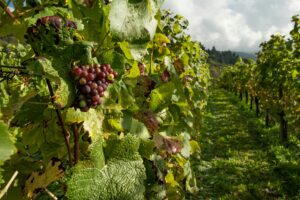Climate change is transforming industries and practices that are centuries old, and the wine industry is no exception. But the effects of climate change on vineyards are anything but straightforward. Overall, there seem to be some short-term gains and definite long-term damage. Whether we consider the present or the future impact, the impact’s magnitude itself is undeniable. For example, temperatures have climbed so much due to global warming that grape harvests now begin about two weeks earlier than they did until 1988.
Wine is a delicate and nuanced agricultural product. Its production is very much dependent on climatic factors, from the health of vines to the content of sugar. Even grapes from the same vineyard can differ every season, depending on the weather. This sensitivity of wine grapes to climate variations is something that makes much of the wine we drink so exquisite, and rare vintages so valued.
Warmer weather is boosting wine quality in the short term
Wine grapes ripen quickly and easily under warm conditions, which results in lower acidity and increased sweetness. The wine produced is fuller and fruitier, with higher levels of alcohol. This can be a welcome trait in places where vine cultivation is otherwise difficult due to cooler climates.
Experts like Professor Gregory Jones, director of the Evenstad Center for Wine Education, agree that warmer conditions can help some variants perform better, “If you’re growing a cool-climate variety in too-cool conditions and it suddenly warms a little bit, you’re going to get more consistency, and more consistently good vintages.”
For example, 2019 was a warm and exciting year for both Bordeaux and Burgundy regions and the yields were delicious and consistent. In the Hautes-Alpes region, temperatures rising by 0.3˚C every decade have distinctly elevated the quality of the wines. Warmer weather has been a boon for the northern regions of Germany as well, where we have had some remarkably ripe and juicy yields in recent years.
Climate warming also helps viable growing areas expand. The ideal location for vineyards used to be between 30 and 50 degrees latitude. But with rising average temperatures, previously uncharted areas and places farther from the equator are also becoming open to viticulture. So, despite being historically unsuited for producing fine wine, England has now been able to make its mark on the global fine wine scene, with newer wines being high on quality and flavours.
Climate change is affecting vineyards in the long term
However, as rosy as the immediate impact of climate change may seem on grape-growing, the long term is filled with serious challenges for viticulture. Despite the success of the 2019 harvest in France, the season was far from ideal. In recent years, there have been multiple heatwaves and water scarcity during the summer, which has negatively affected the vines.
If temperatures continue to rise with forecasted climatic shifts, even grapes that are suited to warmer weather will begin to turn sour beyond a point. Fruits will ripen too quickly, or shrivel if left on the vines for too long, and pigment compounds like tannins will stop developing properly. Naturally, wine quality will suffer, with acidity and alcohol content being impacted in undesirable ways.
Northern Italy has been witnessing sunburnt crops frequently in recent years. In 2019 itself, during one of the hottest summers in recent history, South Australia suffered an 8% loss of white wine varieties while winegrowers in some regions of Spain had to deal with vine damage and scorching at temperatures crossing 42˚C.
The finer factors, like temperature difference between day and night, that contribute to the freshness and flavour of wines are also being thrown into imbalance. But these ramifications aren’t limited to hotter summers and warmer winters. They include volatile events like hailstorms, forest fires, droughts, and floods.
Winter freezes or spring frost may become less frequent but more severe. Disease-causing pests and insects will thrive in shorter or milder winters. Likewise, excessive humidity will encourage the growth of mildew and fungi, and unpredictable rains will result in watery grapes and weak vintages.
NASA has forecasted a 26-inches rise in sea levels by 2100 due to climate change. This will more or less destroy coastlines and impact nearby viticulture practices.Vineyards in countries like Portugal, California, and New Zealand would suffer severe floods and may even be submerged, while inland areas would fall prey to droughts and groundwater salinisation. Water scarcity will contribute to soil damage, erosion, and desertification.
Initially, vines may flourish due to quicker root growth, but stress due to water deficiency will soon slow down photosynthesis, delay the ripening of fruits, lower winter hardiness, or cause the vines to shut down and wither. These damages are too deep and far-reaching to counter with improved irrigation.
A three-year drought in South Africa, for example, has resulted in a decline in vineyard area, poor growth, and small yields since 2005. Parts of Monaco and their vineyards have experienced extreme periods of drought, as have parts along the Côte d’Azur. This kind of climate imbalance will soon bring down the quality of even the finest wines from these regions.
More climatic disruptions are coming, and the wine industry will need to adapt to survive. The concerns go beyond simply the changing taste and quality of wine, and call into question the future of viticulture. While potential solutions like vines engineered to be climate-resistant, smart agricultural practices, and shifting of vineyards to better terrains are being explored, the biggest imperative right now is to cut carbon emissions and reduce our carbon footprint.







